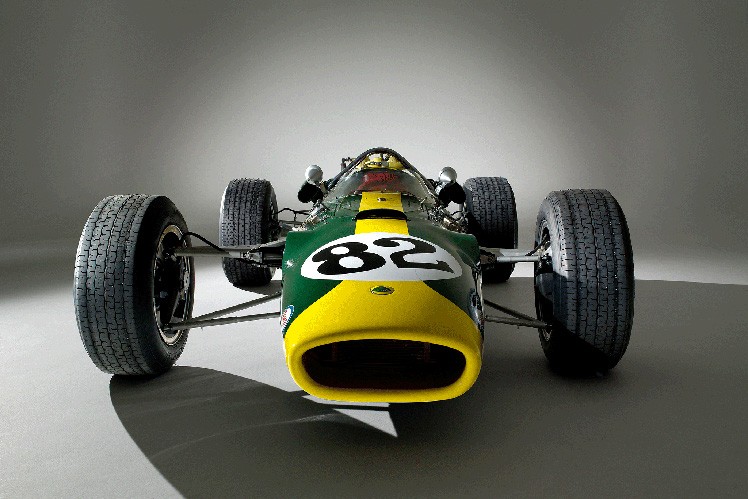

Among Friends – Part 2
Jim Clark alone competed 72 times for Lotus in Formula 1, while Graham Hill became Formula 1 World Champion again in 1968 on a Lotus Type 49, equipped with the 5 DS12 transmission from ZF. With this race car type and ZF technology, drivers won twelve times in world championship races. In addition, Lotus was able to win the Constructors' World Championship in Formula 1 three times during the years with ZF. As a result, Colin Chapman and the Lotus team often paid a visit to Friedrichshafen on their way to Monza.
The DS transmissions have been continuously developed in consultation with Colin Chapman: The 5 DS10 was expanded as the 5 DS12 (120 Nm) and most recently as the 5 DS20. Jim Clark won the legendary Indianapolis 500-mile race in 1965 with the Type 38 and a ZF 5 DS 20, in which the Newton meter figure had already been increased to 200. Jim Clark and Colin Chapman, in gentlemanly fashion, immediately thanked ZF by telegram afterwards, both congratulating ZF on the victory and expressing their enthusiasm for the constructors' achievement. A great gesture, which on the one hand certainly paid tribute to the high engineering skills of the ZF technicians - but on the other hand also reflected the congenial, charming manner of the congratulators and their close, trusting relationship with the designers at Lake Constance.

Although the connection between ZF and Lotus was very much one of partnership, in business terms it lasted only until the end of the 1960s. The tragic events of 1968 with the loss of Jim Clark and Mike Spence certainly shocked ZF employees and in some way slowed down the previously highly praised commitment of the engineers.
Because the helpful commitment from Lake Constance proved to be very time-consuming and cost-intensive in the small quantities involved, only a very small number of transmissions and parts were produced, which the Lotus team had used successfully over the years. It is reported, for example, that Colin Chapman had repeatedly not only strongly praised the ZF transmissions and their reliability and longevity - but he had even noted that no other transmission could be found in all his tests that came close to the reliability of the ZF units. However, he had concerns about supplies in 1963. Accordingly, the 5 DS10 was already running in its third season and the first signs of wear were appearing. In some cases, the aluminum housing no longer played along and began to expand due to the high load. ZF engineers then strengthened it again and again by adding gray cast iron parts to the sides. Jim Clark himself pointed out that even in this generation, speeds of 9,700 rpm were transmitted, but the transmission was only designed for 7,500 rpm.
| Overview of Lotus gearboxes in use | |||
|---|---|---|---|
| Typ 25 | F1 | 1962-65 | ZF 5DS10 |
| Typ 30 | Sports | 1964-65 | ZF 5DS12 |
| Typ 32B | Tasman | 1965 | ZF 5DS20 |
| Typ 33 | F1 | 1964-66 | ZF 5DS10 |
| Typ 34 | Indy | 1964 | ZF 5DS20 |
| Typ 38 | Indy | 1965 | ZF 5DS20 |
| Typ 42 | Indy | 1967 | ZF 5DS20 |
| Typ 48 | F2 | 1967-68 | ZF 5DS12 |
| Typ 49 | F1 | 1967 | ZF 5DS12 |
| Typ 58 | F2 | 1968 | ZF 5DS12 |
| Typ 62 | Sports | 1969 | ZF 5DS12 |
| Typ 63 | F1 (four wheel drive) | 1969 | ZF transfer |
| Typ 64 | F1 (four wheel drive) | 1969 | ZF transfer |
A later reproduction of the first variants was no longer economically feasible, so Colin Chapman began looking for alternatives, especially since he could no longer claim exclusive rights for the subsequent 5 DS12 and 5 DS20 transmission generations. These drive types were also sold to BMW, Ford and Cooper-Maserati. Here too the number of units was extremely manageable: about 60 units of the 5 DS20 were delivered. At Lotus, it was used in the Type 30, Type 32 B (Tasman Car) and the Indianapolis cars Type 34, 38 and Type 42. After 1969, only individual transmission components were delivered to Lotus, such as drive gears and disc bevel gears.
The Lotus team needed fast and flexible solutions in that individual components could be replaced at short notice to be able to tune the transmissions to the respective track. However, this was not feasible with the ZF units: as reliable and precise as they were, they were also as complicated and sophisticated in their internal arrangement and design. It is true that after the world championship success of 1963, the next version 5 DS12 had the first gear reinforced and the oil lubrication improved, and the differential and output shaft were also enlarged. In addition, the shift gate was placed inside the housing, which made it much easier to adjust the shift linkage. In return, this type of transmission was also used in the Lotus Type 48 and Type 58 Formula 2 cars and in the Type 62 sports racing version. Nevertheless, changing gear ratios at short notice was not feasible, so the team still had to bring at least two spare gearboxes for each car: one with a higher and one with a lower axle reduction.
Chapman's son Clive, who today with his Classic Team Lotus looks after the Formula 1 Lotus legends still used in historic racing and restores the legendary monocoques, recalls:

















